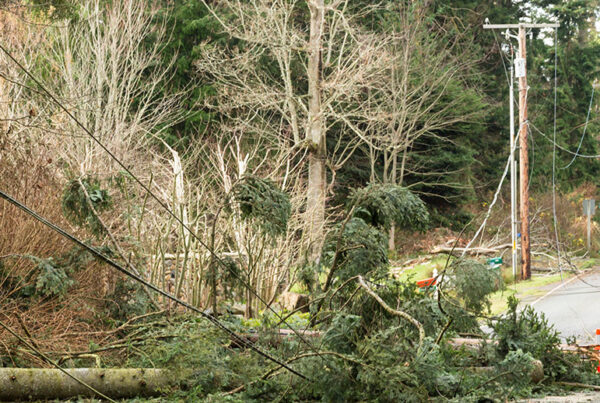
Change is the only constant. Yes, it’s a cliché. But old clichés tend to bear some element of truth.
How do organizations plan strategies of resiliency within an inherently unstable environment? These days, an organization’s ability to withstand and quickly recover from a wide range of disruptive events is key to both surviving and thriving.
How do you do more with less as challenges continue to rise? How do you bridge the gap between high-level resiliency and physical disaster preparedness (i.e., optimizing your capital investment strategies versus ensuring that your sub stations are watertight)?
Building resilience in utilities is crucial to ensuring that energy infrastructure can continue providing reliable power to customers—no matter the weather conditions.
Why does resiliency matter?
Building resiliency, which means building the ability to absorb and adapt in a changing environment, is integral for the following reasons:
- A resilient power utility can continue to provide electricity to customers during and after a disruption, respond promptly to outages, and restore service as soon as possible, thereby reducing the impact of outages.
- Minimizing the cost of damages incurred by disruptive events, as well as limiting the costs associated with lost productivity, revenue and other economic losses, means less money budgeted will be spent reactively.
- Customers expect reliable and consistent service. Resilient power utilities are able to meet these expectations, thereby maintaining customer satisfaction.
- Protecting public safety by reliably providing essential services and preventing economic loss is possible when your organization is resilient enough to minimize the impact of outages.
As the industry continues to work towards decarbonization, the above-mentioned reasons for prioritizing resiliency become all the more important. Electrification provides flexibility by enabling the integration of diverse sources (i.e., renewables, nuclear, natural gas). Ultimately, reducing the world’s dependence on fossil fuels helps to reduce price volatility (over the long-term) and supply chain disruptions, improving overall resiliency.
What do utilities need to build resiliency against?
Resilient organizations anticipate and respond to threats and opportunities, which arise from sudden or gradual changes in their internal and external contexts.
Internal:
- Aging infrastructure. As infrastructure ages, it becomes prone to failure, resulting in service disruptions, safety hazards and added costs. The effects of extreme weather events place further strain on old infrastructure. Upgrading a utility’s equipment and infrastructure reduces the risk of disruption, improves efficiency and reliability, and better maintains the trust of customers and stakeholders.
- Brain drain. The utility industry is staring down the barrel of a workforce crisis. Employees with decades of experience are retiring at a rate that can’t be matched by new hires; when they leave, a large part of their knowledge and expertise leaves with them. Creating a digital business twin of their organizational and industry knowledge, as well as the decision-making processes, is critical to strengthening resiliency for the future.
- Procurement strategy. A failure of procurement strategy can have significant consequences on a utility’s ability to provide reliable and cost-effective services. Developing robust supply chain management plans, which incorporate risk management and contingency planning, can go a long way toward building resiliency. It’s also important to diversify the supplier base, establish backup suppliers, and ensure that procurement strategies can adapt to changing market conditions and other unexpected events.
External:
- Weather events. Extreme weather events are becoming more common, and can have a significant impact on the reliability and safety of a utility’s operations. Investing in infrastructure upgrades, improving grid resilience, and ensuring that critical equipment is protected from flooding and other natural hazards is therefore mandatory. Additionally, leveraging new technologies (i.e., weather forecasting and predictive analytics) can help an organization better prepare.
- Regulatory requirements. Compliance with regulations is critical. Failure to comply can result in significant financial risks and damage a company’s reputation. To build resiliency, utilities need to understand all applicable regulatory requirements, while investing in systems and technologies that enable them to effectively monitor compliance.
- Intermittent power. The increasing use of renewable energy sources like wind and solar can result in power supply fluctuations that impact service reliability. Investing in new technologies and infrastructure that help balance the grid and manage these fluctuations is key. The possibilities are many—from the development of energy storage solutions like batteries—which can hold excess energy and release it during periods of high demand—to smart grid technologies like distribution automation that help to balance the grid.
- Customer behavior. Changes in customer behavior can be triggered by anything—from changes in tech, to weather patterns, to the economy. Investing in systems that let you anticipate and respond to shifts (from shifts in demand, to changes in preference for renewable energy, to the adoption of more efficient technologies) is key. Advanced metering systems, for instance, can provide real-time data on energy consumption and demand, and smart grid technologies can help optimize the use of renewables. Offering pricing incentives that encourage customers to shift energy consumption to periods of low demand also can help.
- Shareholder expectations. Shareholders tend to expect consistent returns on their investments while lso harboring specific expectations around governance, social responsibility and environmental stewardship. Developing strategies that balance the interests of shareholders with those of customers and employees is important. For starters, keep shareholders engaged via transparent communication. Additionally, the development of new revenue streams via the deployment of energy storage solutions, electric vehicle charging infrastructure and other distributed energy resources can go a long way toward satisfying shareholders.
How do utilities build resilient long-term investment strategies?
Ultimately, building resilient long-term investment strategies means building an awareness of factors that affect a utility’s operations—regulatory policies, economic conditions, technological advancements, environmental and social concerns, and customer demands, to name a few.
One of the most effective ways to accomplish meaningful organizational resiliency is by optimizing and future-proofing capital investment strategy with technology that harnesses ‘what-if’ scenario planning and predictive analytics to facilitate strategic decision making. By using the right asset management tools and approaches,
utilities can achieve that ideal balance—the sweet spot between risk, cost and performance.













